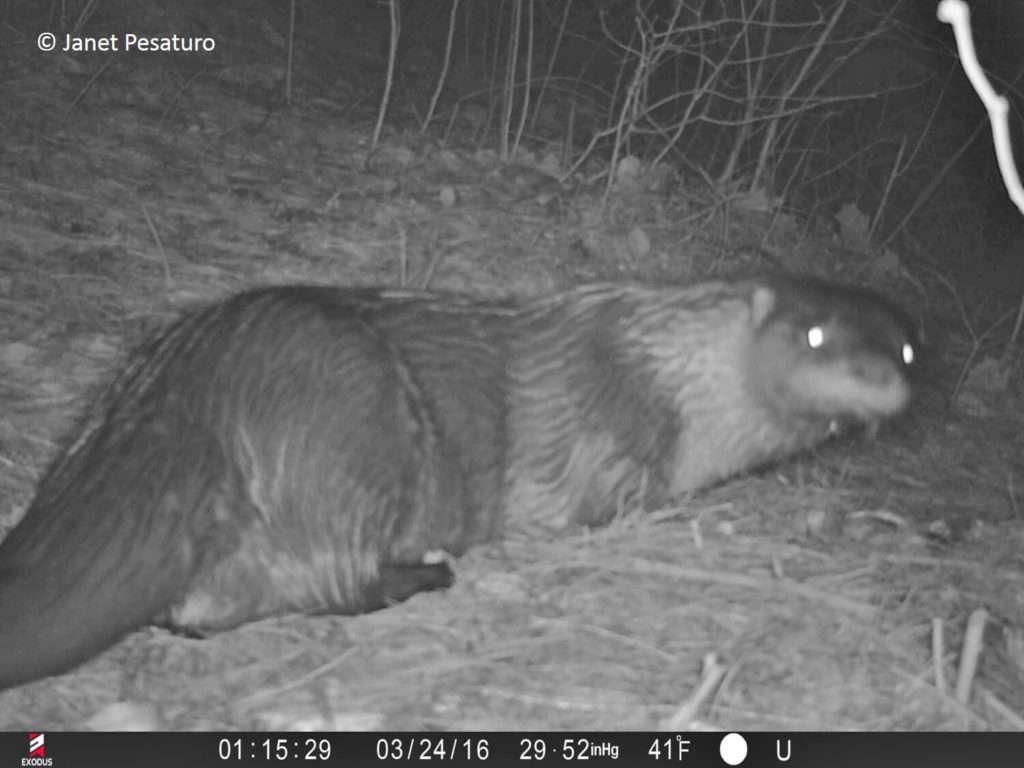River Otters Scent Marking – Video
Scent is an important medium of communication for many animals, and the river otter, Lontra canadensis, takes it to a new level. It seems to make a celebration of elimination. I placed a trail camera on a lake shore in Massachusetts, where otter sign abounded. There were many fish scale filled scats, some carefully placed on mounds of debris and some directly on the sand. The activity was particularly intense on a 15 foot length of shoreline, where I stationed the camera, and there was additional scatting intermittently in either direction. I envisioned a raucous party of scatting, rolling, and grooming. When I checked the camera 5 days later, I was not disappointed. The video below of a group of river otters scent marking, consists of clips from just those few days, so clearly this is an important area for them.

A North American river otter, Lontra canadensis, pauses on the shore.
What struck me as I watched the clips, is that scatting appears to be a major social event for this trio. The video was captured in spring, so the animals could either be a group of males or a mother and 2 young of last year.
The proximate cause of this behavior may be that rolling around feels good, and doing it with friends is fun. The ultimate cause remains a matter of debate. It could be that it gives the animals a “group smell” and marks the shoreline as belonging to them – a way to tell other otters that this area is occupied. The problem is that latrine activity is seasonal, peaking in late winter through spring, falling to nil in summer, peaking to a much lesser degree in fall, and diminishing again in winter. Shoreline scats may provide information about sexual status, but if that’s the case, I’m not sure why group members would roll in each other’s scat.
River Otters Scent Marking Video
Watch the video and notice how they gather up debris into a mound, then paddle the hind feet and wag the tail vigorously, as they eliminate. Why so much fanfare? Maybe that will be the topic of a future post. I hope to keep this camera in place throughout the summer, so we’ll be seeing more of this group.
Notice that one of the otters appears to have only one eye (evident on the night time clips). That will make it easier for us to see differences in the social structure of this group.
Want to see photos of river otter scats, tracks, etc.? Check out this article on River Otter Tracks and Sign.

Excellent camera placement,Janet. Their elaborate elimination gyrations make these otters real naturals on video. An informative and entertaining post.
Thanks, Susan. I’m really excited about this spot, and hope we learn a lot more about these animals over the next few months. They really are entertaining!
This is great. I’m a field research volunteer in California for the SF Bay Area-based River Otter Ecology Project (riverotterecology (dot) org) Nice to see otter action from the other side of the country. Keep it going!
Thanks, Peter, I’ll have to check out that site!
Pingback:Beaver Scent Mound Construction - Video - Winterberry Wildlife
Pingback:River Otter Toilet Training? - Winterberry Wildlife
Pingback:Targeting Unique Habitat Features with Trail Camera - Winterberry Wildlife
Pingback:River Otter Latrines: Finding and Identifying Them - Winterberry Wildlife
Pingback:Sea Otters: Their Mating Habits Explained – Break Out Of The Box
Hi there! This video is great. I aspecially like your question “Why so much fanfare?” since I am doing an ethogram on river otter behaviour mainly on the toppic of mounding and stomping. Have you found any new articles or information on the process of mounding and dancing and why they do it? Thank you!
Hi, I haven’t done a lit search on otter behavior in quite some time, so I don’t know if there’s any new info on them. However, the following video might interest you. In this one you can hear their vocalizations as well as see them scent marking https://www.youtube.com/watch?v=7_7nfBtr8Hs